Convolutional Neural Network-Based Electromagnetic Imaging of Uniaxial Objects in a Half-Space
Abstract
1. Introduction
- To date, there are no existing publications addressing the electromagnetic imaging of buried uniaxial objects in a half-space using artificial intelligence technology. We introduce a novel approach that integrates the DCS with a CNN to tackle the complex nonlinear inverse scattering problem.
- Given that measurements are restricted to the upper space, the range of measuring angles is inherently limited. Our numerical simulations demonstrate that the proposed method effectively images highly nonlinear scatterers with both speed and accuracy while exhibiting robust noise immunity.
- The dielectric constant vector sum derived from the electric field of Transverse Electric (TE) polarized waves manifests as a tensor across the cross-section, presenting greater complexity compared to the dielectric constant vector sum associated with Transverse Magnetic (TM) polarized waves. The interaction between the dielectric constant tensor and the electric field results in strong directional dependence in the TE polarized waves, leading to difficult reconstruction.
- A uniaxial scatterer possesses dielectric constant components that vary with direction. The nonlinear characteristics of the TE polarized waves present considerably more challenges than their TM counterparts, complicating the reconstruction process using the scattered fields.
- We successfully amalgamate the DCS with CNN methodologies to reconstruct electromagnetic images of buried objects in a half-space environment. Our numerical analyses reveal the reconstruction efficacy of this combined approach. To validate the robustness of our method, we employ a pretrained model to reconstruct scenarios involving high dielectric constant distributions. The results confirm that our technique maintains high reliability, even in half-space settings.
2. Theory
2.1. Direct Problems
2.2. Inverse Problem
2.2.1. BPS
2.2.2. DCS
3. Convolutional Neural Network
- Skip connections between the input and output layers of a CNN play a critical role in addressing the vanishing gradient problem, ensuring a more consistent gradient flow during backpropagation.
- Down-sampling in the contraction pathway of a CNN expands the receptive data, which improves the network’s ability to make accurate pixel-level predictions in the output.
- Batch normalization, an integral component of the CNN architecture, mitigates internal covariate shift, accelerates convergence, and reduces sensitivity to parameter initialization and gradient instability.
4. Numerical Result
4.1. Relative Permittivity Between 3.5 and 4
4.2. Relative Permittivity Between 4 and 4.5
4.3. Relative Permittivity Between 4.5 and 5 Using the Model in Section 4.2
5. Conclusions
Author Contributions
Funding
Institutional Review Board Statement
Informed Consent Statement
Data Availability Statement
Conflicts of Interest
References
- Uecker, M.; Hohage, T.; Block, K.T.; Frahm, J. Image reconstruction by regularized nonlinear inversion-joint estimation of coil sensitivities and image content. Magn. Reson. Med. 2008, 60, 674–682. [Google Scholar] [CrossRef]
- Deisboeck, T.; Kresh, J.Y. Complex Systems Science in Biomedicine; Springer Science & Business Media: New York, NY, USA, 2007. [Google Scholar]
- Song, L.P.; Yu, C.; Liu, Q.H. Through-wall imaging (TWI) by radar: 2-D tomographic results and analyses. IEEE Trans. Geosci. Remote Sens. 2005, 43, 2793–2798. [Google Scholar] [CrossRef]
- Chen, X.; Wei, Z.; Li, M.; Rocca, P. A Review of Deep Learning Approaches for Inverse Scattering Problems. Prog. Electromagn. Res. 2020, 167, 67–81. [Google Scholar] [CrossRef]
- Sanghvi, Y.; Kalepu, Y.; Khankhoje, U.K. Embedding Deep Learning in Inverse Scattering Problems. IEEE Trans. Comput. Imaging 2020, 6, 46–56. [Google Scholar] [CrossRef]
- Habashy, T.M.; Groom, R.W.; Spies, B.R. Beyond the Born and Rytov approximations: A nonlinear approach to electromagnetic scattering. J. Geophys. Res. Solid Earth 1993, 98, 1759–1775. [Google Scholar] [CrossRef]
- Belkebir, K.; Chaumet, P.C.; Sentenac, A. Super resolution in total internal reflection tomography. J. Opt. Soc. Amer. A 2005, 22, 1889–1897. [Google Scholar] [CrossRef]
- Chen, X. Computational Methods for Electromagnetic Inverse Scattering; Wiley-IEEE Press: New York, NY, USA, 2018. [Google Scholar]
- Chew, W.C.; Wang, Y.-M. Reconstruction of two-dimensional permittivity distribution using the distorted Born iterative method. IEEE Trans. Med. Imaging 1990, 9, 218–225. [Google Scholar] [CrossRef]
- Van DenBerg, P.M.; Kleinman, R.E. A contrast source inversion method. Inverse Probl. 1997, 13, 1607. [Google Scholar]
- Chen, X. Subspace-based optimization method for solving inverse scattering problems. IEEE Trans. Geosci. Remote Sens. 2010, 48, 42–49. [Google Scholar] [CrossRef]
- Yao, H.M.; Sha, W.E.I.; Jiang, L. Two-Step Enhanced Deep Learning Approach for Electromagnetic Inverse Scattering Problems. IEEE Antennas Wirel. Propag. Lett. 2019, 18, 2254–2258. [Google Scholar] [CrossRef]
- Zhang, H.H.; Yao, H.M.; Jiang, L.; Ng, M. Enhanced Two-Step Deep-Learning Approach for Electromagnetic-Inverse-Scattering Problems: Frequency Extrapolation and Scatterer Reconstruction. IEEE Trans. Antennas Propag. 2023, 71, 1662–1672. [Google Scholar] [CrossRef]
- Yao, H.M.; Zhang, H.H.; Jiang, L.; Ng, M. Enhanced Deep Learning Approach for Electromagnetic Forward Modeling of Dielectric Target Within the Wide Frequency Band Using Deep Residual Convolutional Neural Network. IEEE Antennas Wirel. Propag. Lett. 2024, 23, 1884–1888. [Google Scholar] [CrossRef]
- Wei, Z.; Chen, X. Deep-Learning Schemes for Full-Wave Nonlinear Inverse Scattering Problems. IEEE Trans. Geosci. Remote Sens. 2019, 57, 1849–1860. [Google Scholar] [CrossRef]
- Zhang, L.; Xu, K.; Song, R.; Ye, X.; Wang, G.; Chen, X. Learning-Based Quantitative Microwave Imaging with a Hybrid Input Scheme. IEEE Sens. J. 2020, 20, 15007–15013. [Google Scholar] [CrossRef]
- Zhou, Y.; Zhong, Y.; Wei, Z.; Yin, T.; Chen, X. An Improved Deep Learning Scheme for Solving 2-D and 3-D Inverse Scattering Problems. IEEE Trans. Antennas Propag. 2021, 69, 2853–2863. [Google Scholar] [CrossRef]
- Song, R.; Huang, Y.; Ye, X.; Xu, K.; Li, C.; Chen, X. Learning-Based Inversion Method for Solving Electromagnetic Inverse Scattering with Mixed Boundary Conditions. IEEE Trans. Antennas Propag. 2022, 70, 6218–6228. [Google Scholar] [CrossRef]
- Wang, Y.; Zhao, Y.; Wu, L.; Yin, X.; Zhou, H.; Hu, J.; Nie, Z. An Early Fusion Deep Learning Framework for Solving Electromagnetic Inverse Scattering Problems. IEEE Trans. Geosci. Remote Sens. 2023, 61, 2005914. [Google Scholar] [CrossRef]
- Wu, Z.; Peng, Y.; Wang, P.; Wang, W.; Xiang, W. A Physics-Induced Deep Learning Scheme for Electromagnetic Inverse Scattering. IEEE Trans. Microw. Theory Tech. 2024, 72, 927–947. [Google Scholar] [CrossRef]
- Chiu, C.C.; Lee, G.Z.; Jiang, H.; Hong, B.J. Microwave Imaging of a Periodic Homogeneous Dielectric Object Buried in Rough Surfaces. J. Electromagn. Waves Appl. 2019, 33, 1905–1919. [Google Scholar] [CrossRef]
- Topbaş, T.O.; Alkumru, A. A hybrid method for an inverse scattering problem related to cylindrical bodies buried in a half-space. Appl. Math. Sci. Eng. 2023, 31, 2248355. [Google Scholar] [CrossRef]
- Chiu, C.-C.; Chien, W.; Yu, K.-X.; Chen, P.-H.; Lim, E.H. Electromagnetic Imaging for Buried Conductors Using Deep Convolutional Neural Networks. Appl. Sci. 2023, 13, 6794. [Google Scholar] [CrossRef]
- Chiu, C.C.; Lee, Y.H.; Chen, P.H.; Shih, Y.C.; Jiang, H. Application of Self-Attention Generative Adversarial Network for Electromagnetic Imaging in Half-Space. Sensors 2024, 24, 2322. [Google Scholar] [CrossRef] [PubMed]
- Li, L.; Wang, L.G.; Teixeira, F.L.; Liu, C.; Nehorai, A.; Cui, T.J. DeepNIS: Deep Neural Network for Nonlinear Electromagnetic Inverse Scattering. IEEE Trans. Antennas Propag. 2019, 67, 1819–1825. [Google Scholar] [CrossRef]
- Cheng, Y.; Xiao, L.-Y.; Zhao, L.-Y.; Hong, R.; Liu, Q.H. A 3-D Full Convolution Electromagnetic Reconstruction Neural Network (3-D FCERNN) for Fast Super-Resolution Electromagnetic Inversion of Human Brain. Diagnostics 2022, 12, 2786. [Google Scholar] [CrossRef]
- Zhang, H.; Chen, Y.; Cui, T.J.; Teixeira, F.L.; Li, L. Probabilistic Deep Learning Solutions to Electromagnetic Inverse Scattering Problems Using Conditional Renormalization Group Flow. IEEE Trans. Microw. Theory Tech. 2022, 70, 4955–4965. [Google Scholar] [CrossRef]
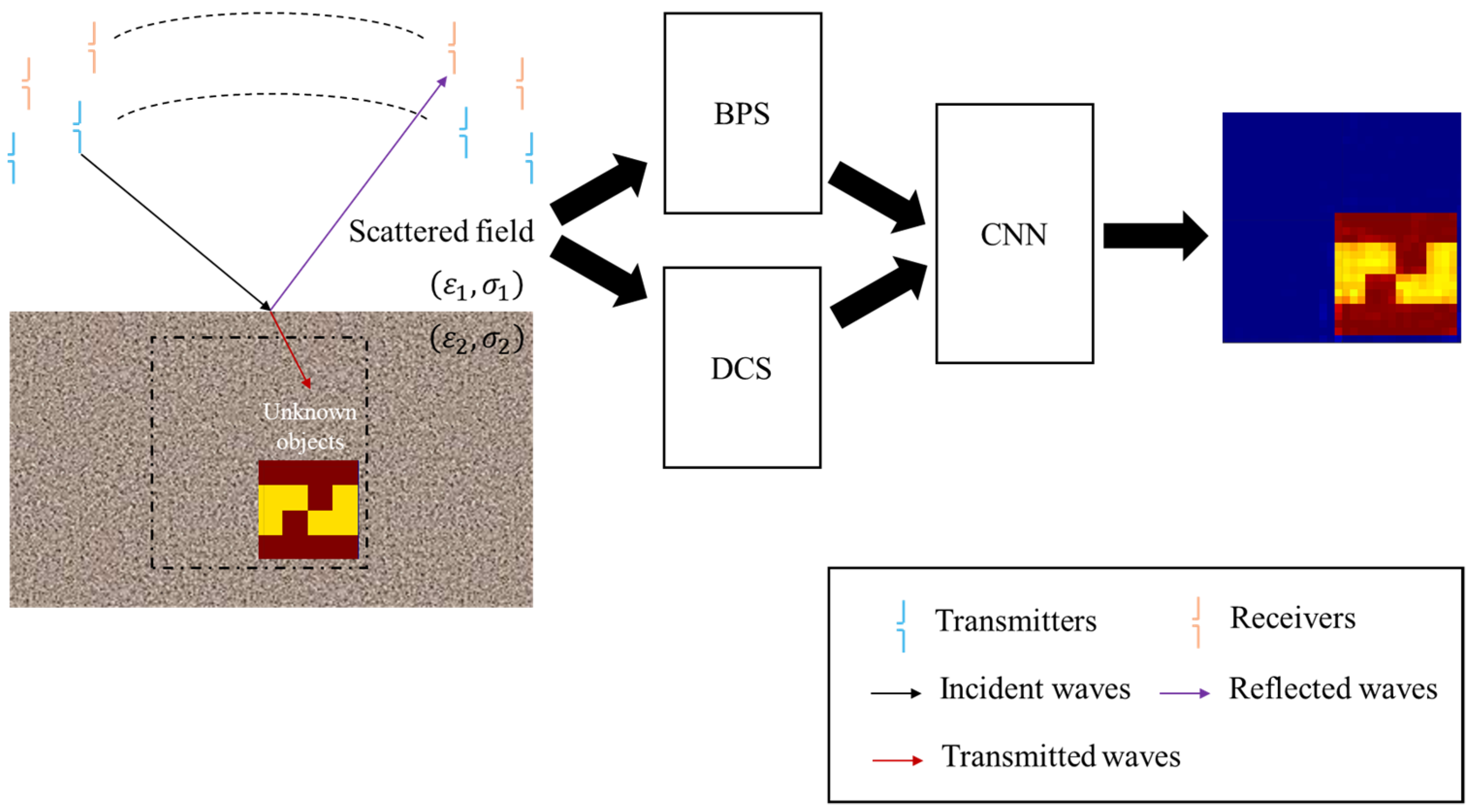
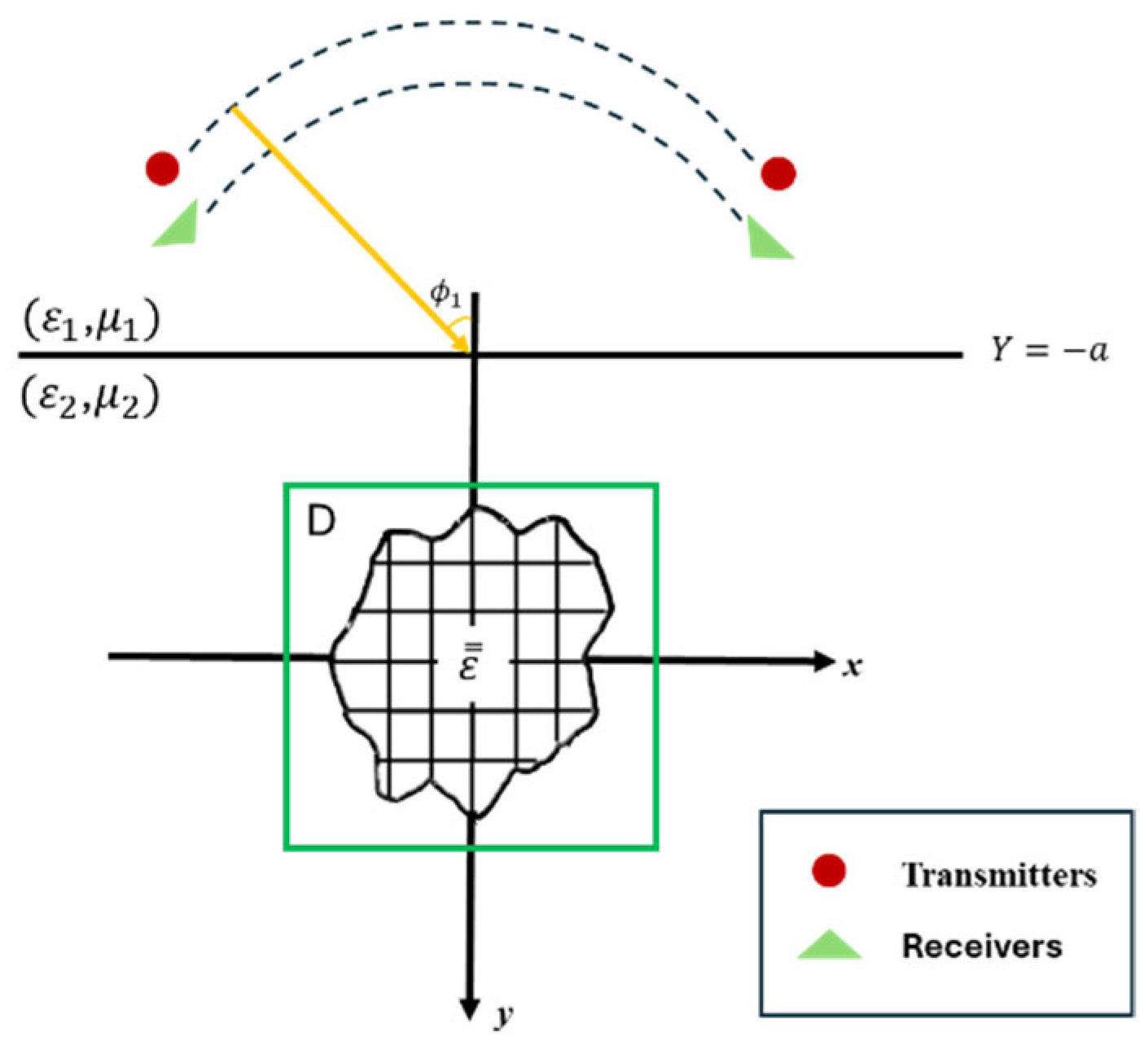
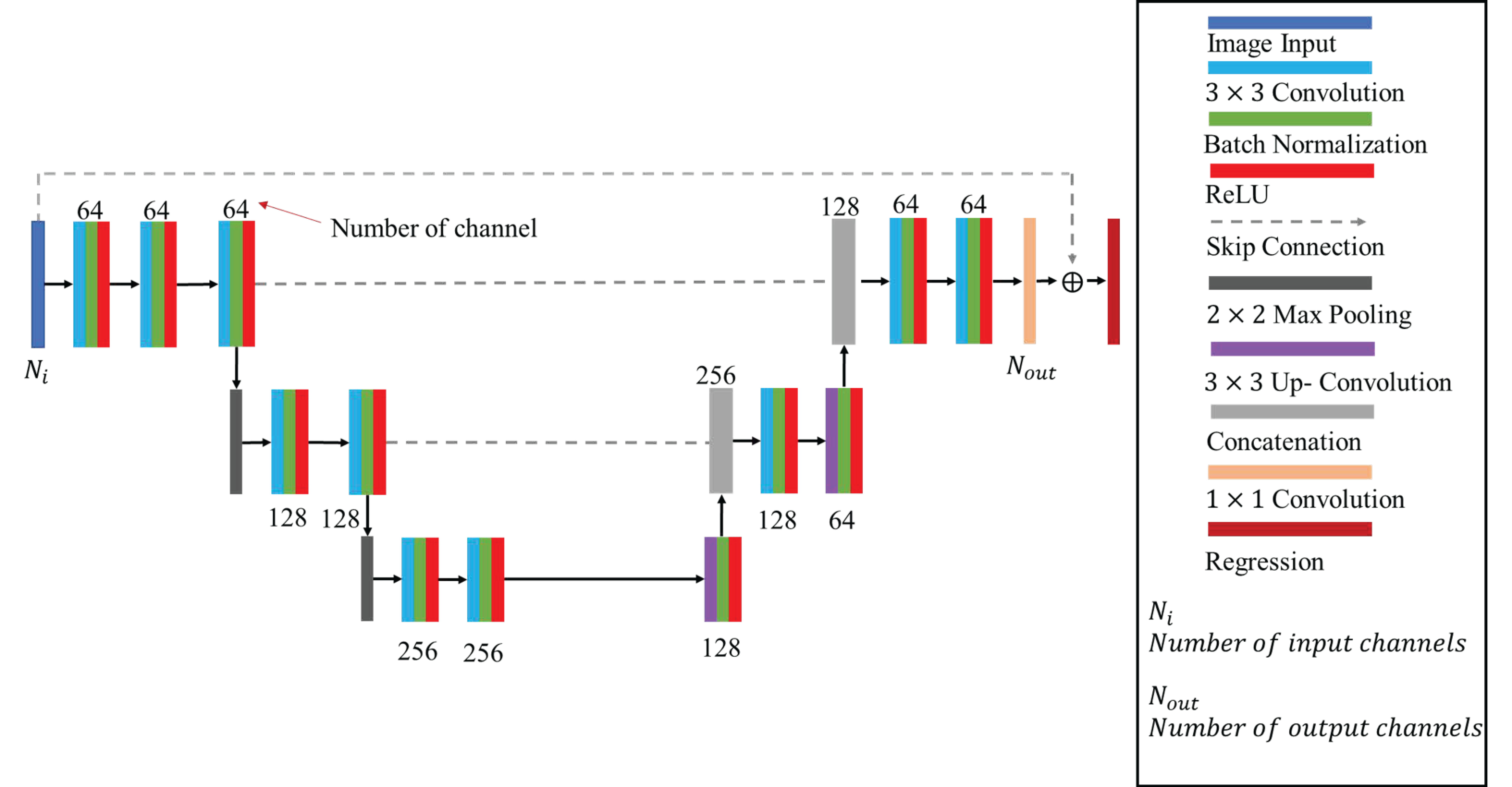
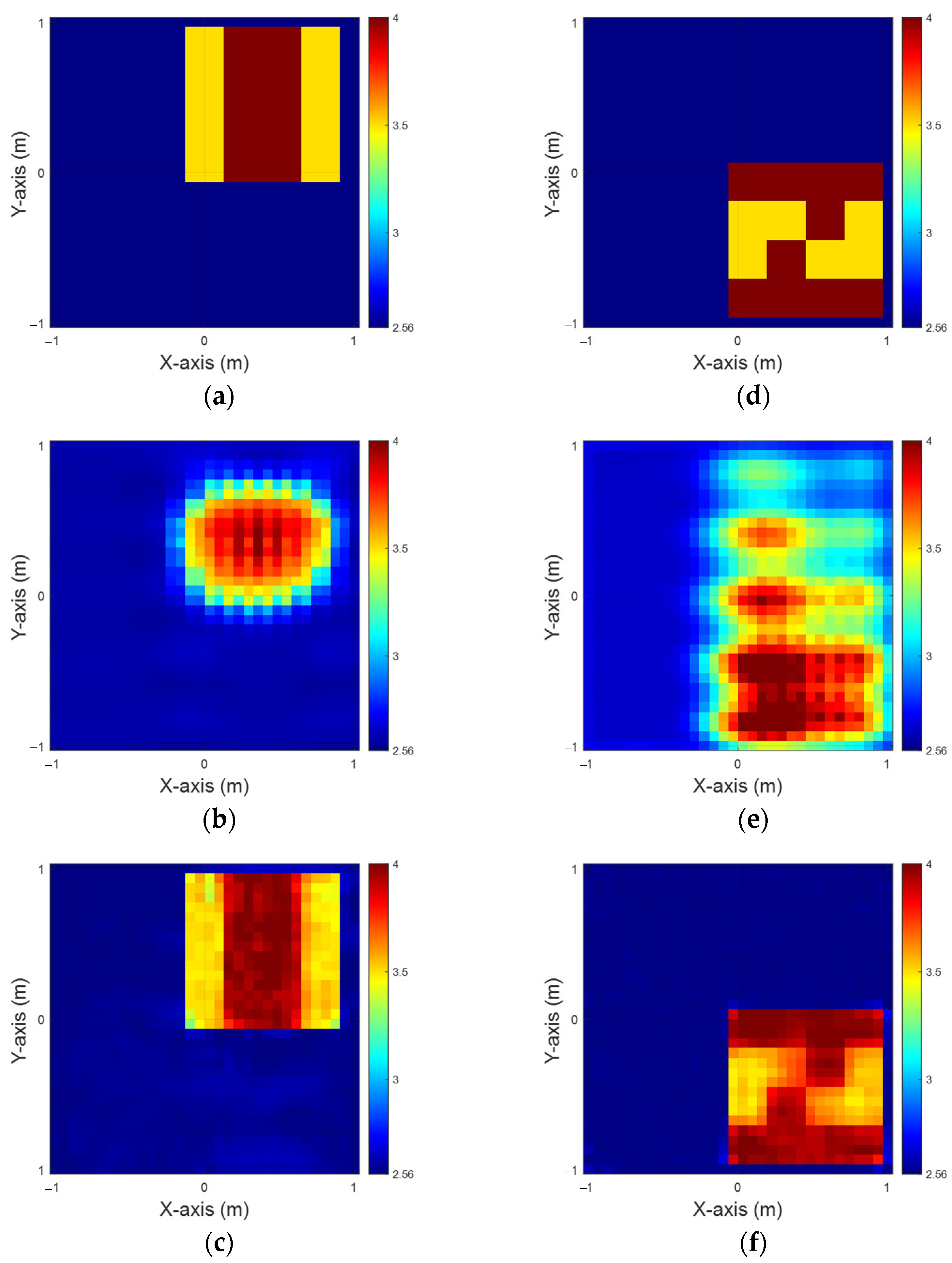
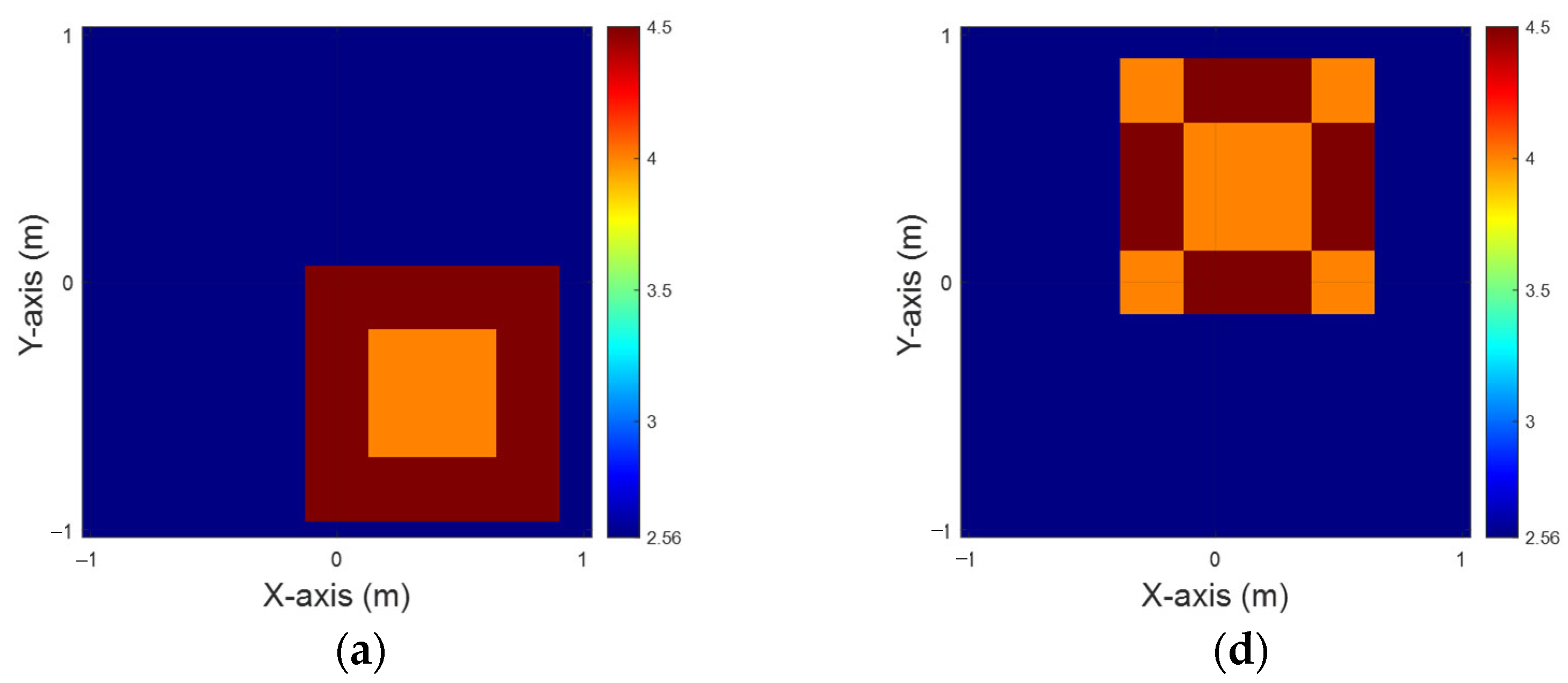
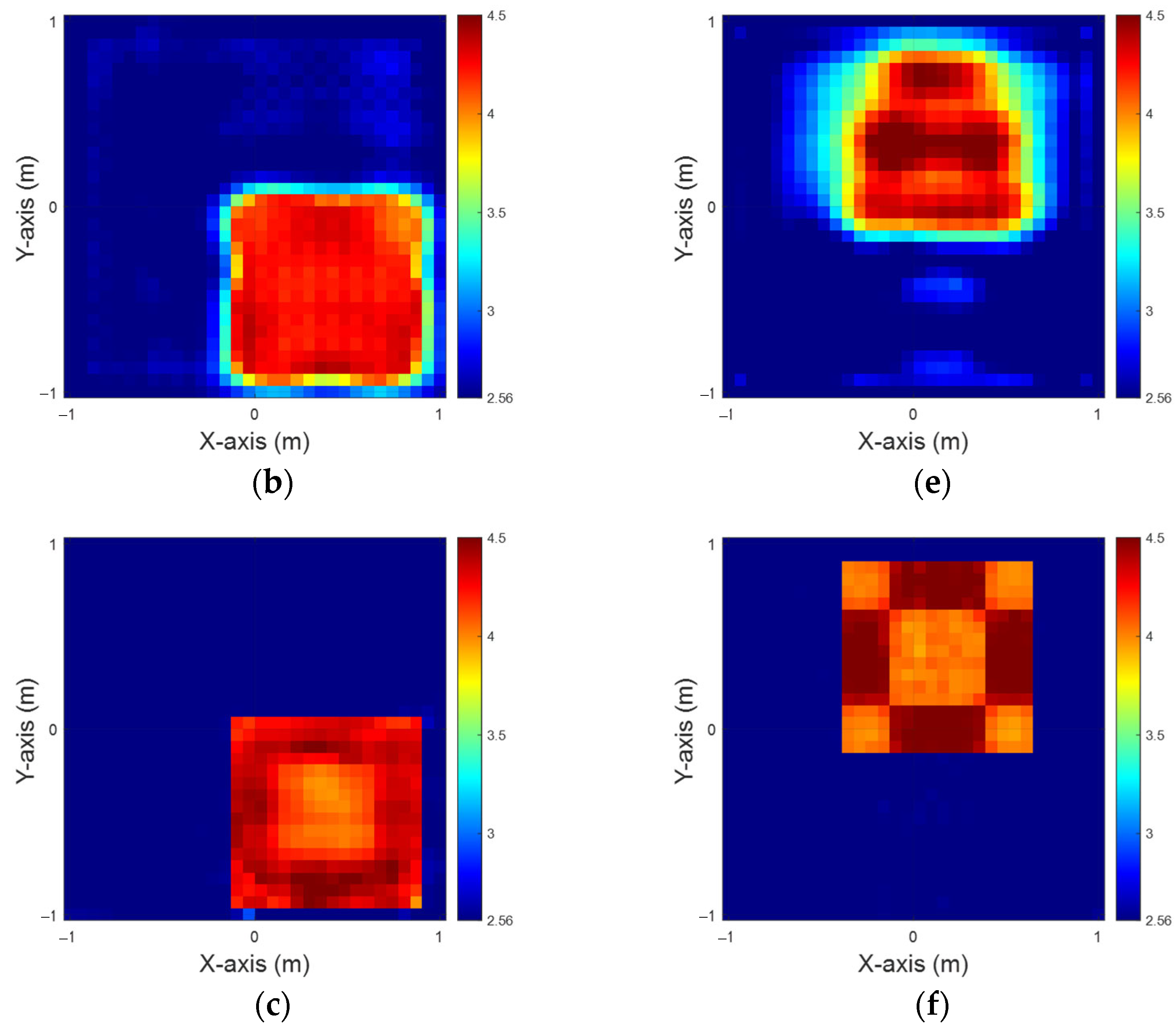

| Performance | ||||
|---|---|---|---|---|
| BPS | DCS | BPS | DCS | |
| RMSE | 12.03% | 1.43% | 16.37% | 1.25% |
| SSIM | 57.32% | 95.9% | 29.19% | 99.02% |
| Performance | ||||
|---|---|---|---|---|
| BPS | DCS | BPS | DCS | |
| RMSE | 7.8% | 3.12% | 9.72% | 0.82% |
| SSIM | 81.02% | 97.46% | 78.76% | 99.62% |
| Performance | ||
|---|---|---|
| RMSE | 9.04% | 8.02% |
| SSIM | 91.28% | 96.04% |
Disclaimer/Publisher’s Note: The statements, opinions and data contained in all publications are solely those of the individual author(s) and contributor(s) and not of MDPI and/or the editor(s). MDPI and/or the editor(s) disclaim responsibility for any injury to people or property resulting from any ideas, methods, instructions or products referred to in the content. |
© 2025 by the authors. Licensee MDPI, Basel, Switzerland. This article is an open access article distributed under the terms and conditions of the Creative Commons Attribution (CC BY) license (https://creativecommons.org/licenses/by/4.0/).
Share and Cite
Chiu, C.-C.; Chiang, J.-S.; Chen, P.-H.; Jiang, H. Convolutional Neural Network-Based Electromagnetic Imaging of Uniaxial Objects in a Half-Space. Sensors 2025, 25, 1713. https://doi.org/10.3390/s25061713
Chiu C-C, Chiang J-S, Chen P-H, Jiang H. Convolutional Neural Network-Based Electromagnetic Imaging of Uniaxial Objects in a Half-Space. Sensors. 2025; 25(6):1713. https://doi.org/10.3390/s25061713
Chicago/Turabian StyleChiu, Chien-Ching, Jen-Shiun Chiang, Po-Hsiang Chen, and Hao Jiang. 2025. "Convolutional Neural Network-Based Electromagnetic Imaging of Uniaxial Objects in a Half-Space" Sensors 25, no. 6: 1713. https://doi.org/10.3390/s25061713
APA StyleChiu, C.-C., Chiang, J.-S., Chen, P.-H., & Jiang, H. (2025). Convolutional Neural Network-Based Electromagnetic Imaging of Uniaxial Objects in a Half-Space. Sensors, 25(6), 1713. https://doi.org/10.3390/s25061713










